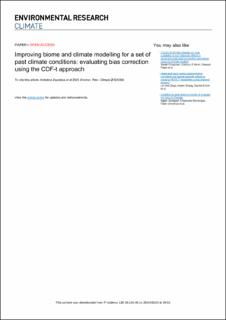| dc.contributor.author | Zapolska, Anhelina | |
| dc.contributor.author | Vrac, Mathieu | |
| dc.contributor.author | Quiquet, Aurélien | |
| dc.contributor.author | Extier, Thomas | |
| dc.contributor.author | Arthur, Frank | |
| dc.contributor.author | Renssen, Hans | |
| dc.contributor.author | Roche, Didier M. | |
| dc.date.accessioned | 2023-11-17T13:34:01Z | |
| dc.date.available | 2023-11-17T13:34:01Z | |
| dc.date.created | 2023-10-11T13:45:44Z | |
| dc.date.issued | 2023 | |
| dc.identifier.citation | Zapolska, A., Vrac, M., Quiquet, A., Extier, T., Arthur, F., Renssen, H. & Roche, D. M. (2023). Improving biome and climate modelling for a set of past climate conditions: evaluating bias correction using the CDF-t approach. Environmental Research: Climate, 2(2), Artikkel 025004. | en_US |
| dc.identifier.issn | 2752-5295 | |
| dc.identifier.uri | https://hdl.handle.net/11250/3103283 | |
| dc.description.abstract | Climate model simulations are inherently biased. It is a notably difficult problem when dealing with climate impact assessments and model-data integration. This is especially true when looking at derived quantities such as biomes, where not only climate but also vegetation dynamics biases come into play. To overcome such difficulties, we evaluate the performance of an existing methodology to correct climate model outputs, applied here for the first time to long past climate conditions. The proposed methodology relies on the 'Cumulative Distribution Function-transform' (CDF-t) technique, which allows to account for climate change within the bias-correction procedure. The results are evaluated in two independent ways: (i) using forward modelling, so that model results are directly comparable to reconstructed vegetation distribution; (ii) using climatic reconstructions based on an inverse modelling approach. The modelling is performed using the intermediate complexity model iLOVECLIM in the standard global and interactively downscaled over the Europe version. The combined effects of dynamical downscaling and bias correction resulted in significantly stronger agreement between the simulated results and pollen-based biome reconstructions (BIOME6000) for the pre-industrial (0.18 versus 0.44) and mid-Holocene (MH) (0.31 versus 0.40). Higher correlation is also observed between statistically modelled global gridded potential natural distribution and modelled biomes (0.36 versus 0.41). Similarly, we find higher correlation between the reconstructed and the modelled temperatures for the MH (0.02 versus 0.21). No significant difference is found for the Last Glacial Maximum when using temperature reconstructions, due to the low number of data points available. Our findings show that the application of the CDF-t method on simulated climate variables enables us to simulate palaeoclimate and vegetation distribution in better agreement with independent reconstructions. | en_US |
| dc.language.iso | eng | en_US |
| dc.rights | Navngivelse 4.0 Internasjonal | * |
| dc.rights.uri | http://creativecommons.org/licenses/by/4.0/deed.no | * |
| dc.title | Improving biome and climate modelling for a set of past climate conditions: evaluating bias correction using the CDF-t approach | en_US |
| dc.type | Journal article | en_US |
| dc.description.version | publishedVersion | en_US |
| dc.rights.holder | © 2023 The Author(s). | en_US |
| dc.source.volume | 2 | en_US |
| dc.source.journal | Environmental Research: Climate | en_US |
| dc.source.issue | 2 | en_US |
| dc.identifier.doi | https://doi.org/10.1088/2752-5295/accbe2 | |
| dc.identifier.cristin | 2183761 | |
| dc.source.articlenumber | 025004 | en_US |
| cristin.ispublished | true | |
| cristin.fulltext | original | |

